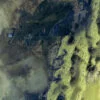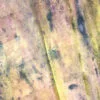For a year or two after my brother Paul died, my parents would see a bird – maybe a magpie or a blackbird or another well-known species – that was behaving strangely. This bird (they would report later) would seem to follow them, or would reappear a few times over the course of a day, or else it wouldn’t fly away when one or both of them approached. And, half joking, they would associate the presence of this bird with the absence of their son, Paul, as if the creature was somehow also Paul, only now in bird form. This annoyed me the few times they told me about it, though I didn’t really know why at the time, and I’m ashamed now of how priggish I was.
Three weeks before his twenty-third birthday, sometime after one in the morning, about two weeks after Christmas, Paul left a bar and called my phone a few times without success. After a while he sent a text message to say goodnight, and that he loved me, and that he loved our parents too. And then at some point, at the edge of the harbour, when he would have been about halfway home, he took off our father’s leather jacket, folded it carefully on the ground and entered the water. How do you understand something like that through an afterlife of birds?
Thinking back, though, I’m not sure that this attention to birdlife came from a very direct belief in reincarnation on the part of my parents. It seems more likely to me now that they were simply open to the idea that some part of a person might become present again after death; that a dead person might make themselves known, if only obliquely, and in forms that are not always predictable; that birds and cats, occasionally baby foxes, were as likely a channel as any other for such an encounter. For a while, though I would certainly not have admitted it then, I too looked with particular intensity at birds. But I never saw anything strange. After a while, my parents stopped noticing these incidents, or at least they no longer said anything to me. Maybe these acts of mediation stopped altogether. Or maybe the media themselves took on different forms. Either way, I never heard any more about it.
In an essay published in the Année sociologique in 1907, a young French scholar, Robert Hertz, proposed that a person’s death should be thought of as a collective or social event, and not simply an individual calamity. ‘When a man dies,’ Hertz wrote, ‘society loses in him much more than a unit; it is stricken in the very principle of its life, in the faith it has in itself.’ Hertz had recently returned to Paris from London, where he had been researching a project on death rituals in the British Museum. He was trying to show that what we call ‘mourning’ is not really about grief or sadness. Rather it is about managing the transition of the soul to another realm, such that the missing person – and thus the social world of which they were part – might go on.
Hertz had drawn much of his evidence from writings about peoples he called the Dayak – a loose term to describe different non-Muslim Indigenous groups in Borneo. The island, including its many Indigenous groups, had been caught up in European imperialism since the mid-nineteenth century, and been made visible in the kinds of anthropological and orientalist writing that often travelled with colonisation. In an introduction to a much later translation of Hertz, the English anthropologist Rodney Needham notes that the word ‘Dayak’ is an invention of early Dutch ‘ethnographers’ and that Hertz was likely talking about a group that Needham called the Olo Ngaju, in south-eastern Borneo. How much Hertz’s description can be related to people who identify with, or are identified by others with, Dayak communities today – the term is currently used particularly in Indonesia – remains unclear.
Nonetheless, having studied these texts with some care, Hertz argued that what was at stake in the funerary practices of peoples within some Dayak communities – in the management of decomposition, the practice of double burial, the lengthy social isolation of the dead person’s kin – is not a simple act of grieving or remembrance, it is rather a collective attempt to overcome, even to undo, death. He described how, among one group, the custom was to keep the coffin at home for some time, pierced at the bottom, and with a basin underneath, to catch the liquids that escape during the process of decomposition. These liquids were mixed with rice, which was then eaten by the dead person’s family during the mourning period. Thus, says Hertz, ‘the living incorporate into their own being the vitality and the special qualities residing in the flesh of the deceased’. After all, he reasoned, if a person is truly a social being as much as a corporeal one, then their death, which is in one sense the death of the social order itself, is literally unconscionable. ‘The last word must remain with life,’ Hertz argued, ‘the deceased will rise from the grip of death and will return, in one form or another, to the peace of human association.’
Hertz was a pupil of Émile Durkheim, whose own study, Suicide, now regarded as a foundational text of European social science, had been published ten years before. By comparing patterns of suicide in different European countries, Durkheim showed that what we often imagine as the most supremely individual and psychological act – the act of self-killing – in fact follows a regular and predictable social pattern. Men are much more likely to kill themselves than women, he wrote, and divorced men even more so. Protestants are more likely than Catholics to take their own lives, as are soldiers more likely than civilians. People kill themselves in warmer rather than colder months, during economic crises and periods of upheaval, in Denmark more than in Norway or Sweden. These findings, he argued, and their clear patterning, tell us that suicide is not a great individual reckoning with the world. It is, like everything else, a product of culture. Whatever else one might say about Durkheim, it has always struck me that there is a kind of perverse, even cruel, genius in observing that even the desire for obliteration might be part of the mundane human work of remaking the social order – in turning even a suicide into a kind of regeneration. Such, at least, are the doleful lessons of undergraduate social science: nothing belongs to you, not even your own self-destruction. No less than Durkheim, the stakes of Hertz’s texts are not so much with Indigenous peoples in Borneo – here, as ever, anthropology is at best a partial guide – but are rather more to do with a group of European men, conjuring death and reproduction on the eve of catastrophe. Hertz died less than a decade after publishing his essay, at the age of thirty-three having volunteered for service in the First World War. He was one of several of Durkheim’s pupils killed in that conflict, though whether Durkheim thought of this collective self-sacrifice as the mere unfolding of social order is not known. Here we are, at any rate, surrounded by war, colonisation, murder and suicide. Society, indeed, stricken in the very principle of its social life.
I first read these texts in detail about five years after Paul died. By the time I was reading them, I had left my parents’ house for a small university town in the east of England, to try to become an anthropologist and begin a lifelong study of mental distress in comparative and cross-cultural contexts. I had spent the years before in a generalised torpor. At home, this had been understood and made legible as a depression, a situation that, in its treatment and narration, including by a very good psychiatrist, was not understood to have much to do with Paul – though, obviously, it had a lot to do with him. I don’t mean that it came from a sense of sadness about Paul’s death. This torpor came, rather, from an anger with him, even from a kind of hatred that, so many years later, could not be neatly packaged up as grief. What a fucking idiot he had been, truly, it seemed to me. Stupid, destructive, melodramatic, predictable Paul.
What we call mourning is hard, says the psychoanalyst Darian Leader, ‘not because we loved someone too much, as common sense might suggest, but because our hatred [is] so powerful’. This hate can turn inwards, settling into the state of self-loathing we sometimes still call melancholia. In his famous essay on mourning and melancholia, Freud suggested that there is sometimes even a kind of ‘sadistic satisfaction’ in continuing to produce the pain. Under conditions of melancholia, says Freud, the melancholic himself becomes a secondary figure. His true interest is in inflicting punishment on the lost object or person – the dead or departed whose absence he finds so unbearable that he has come to replace them, wholly, with himself.
I don’t know. In my own case, the simple fact of departure from home – and in its own way, of reading – had had an unexpected therapeutic effect. Somewhere in deepest England, where I spent most of my time concerned with the Trobriand Islands and highland Papua New Guinea, with Azande witchcraft, and Samoan adolescence, eventually, too, with the very different ways that humans make sense of madness and death and remembrance – something began to move. I remember first encountering Hertz’s story about the decomposition and the rice. There was something in that very careful and deliberate act of ingestion, its mixture of tenderness and aggression (the corpse is always, Hertz reminds us, an ambivalent and transitional object) that told me something important about what it could mean to truly mourn someone like Paul, and about what such mourning was for. It also contained a lesson – though I did not quite understand this at the time – about what such mourning might yet do.
Just before the embryo that eventually became our son, Paulie, was implanted, my wife Aoife and I were waiting, very bored, in an anteroom at a public fertility clinic – this was about fifteen years after Paul’s death – and a woman approached us and introduced herself as our embryologist. She said that she had graded our embryos – these had been growing in a dish for seven days – and the news was not great. There are four grades, she said, from A to D, for measuring the quality of an embryo. Only two of our embryos were viable in the first place, and these were both grade C. Because the chance of our now having a live birth from either of these was not so great, she was willing, if we wanted it, to transfer both embryos. However (she warned us) transferring both would increase the odds of a multiple birth, and all the extra risks that this brought. Did we want this?
About an hour later, Aoife was strapped into an inverted dental chair in the operating theatre, while I was directed by the obstetrician towards a large flat-screen television in the corner. On the screen there was an enormous, milk-grey image of two embryos, silently, but very clearly, dividing on a glass plate, pulsing at the edges of their own membranes, as if at any moment they might break free, slide their way out through the empty hospital corridors and into the rainy streets outside. ‘It’s okay to take a photograph,’ the doctor said, though in fact I had no desire at all to take one. What could I do? I took a photograph and gave a weak thumbs up.
Then very quickly the television went off. The embryologist emerged rather suddenly and theatrically from a side room holding a thin plastic wand. She handed it to the obstetrician, who, in a single unbreaking motion, took the rod and inserted it with a very straight, deliberate movement into the centre of Aoife’s body. All four of us stared at a tiny monitor that showed an image of Aoife’s insides: the rod entered stage right, there was an almost imperceptible jerk back, and then the obstetrician just as quickly withdrew. On the screen a tiny white dot drifted slowly, uncertainly, into the cavernous womb, like an astronaut, I thought, abandoned by his ship. The rod returned and the consultant repeated the motion. A second dot flashed onto the screen and moved anxiously, but unstoppably, towards its sibling.
What ever happened to that second embryo? Where is the sibling of the single boy who was pulled – late, grey, shocked into silence – from Aoife’s womb, more than forty weeks later? Did he disappear or was he absorbed into her body? Did he give up? Did he wither away? This second figure, this brother embryo as I have chosen to gender him, was never mentioned again. And if such terms seem ludicrous for an entity barely visible off a glass plate – a crustacean at the end of a wand; a small blast of light in the space-womb – if there is something suspicious, maybe even a bit religious, certainly very heteronormative, about asking after him, still I want to ask after him. I want to conjure this tiny, white pulse, however uselessly, into a single moment of life. And I want to place him within the family constellation, at least to the extent that his unspoken disappearance becomes worthy of consideration. I know this is madness. But oh Paul, Paulie, I think, remembering that awful television screen. Which one was you, and which was me?
When a baby is born, there is some work of figuring out – of laying claim to – who the baby looks like. At least this is the case in Irish families, where questions of generation and inheritance – of who or what belongs to whom or what – are rarely far below the surface. Does the child have a gap between his teeth? Weird eyes? Red hair? Is she like Uncle Pat or Aunty Mary? This work of looking and noticing is itself, of course, much like the funerary ritual at the other end of life, a performative act. Which is to say, it is not simply about the recognition of ties, but rather their creation. To trace Uncle Pat’s nose across the unlucky child’s face is not an innocent process of seeing; it is an argument and a claim. My father is insistent that Paulie looks like him, though the resemblance is obscure to me. Nonetheless, I recognise, and even respect, this as an active labour of making something – someone – familiar.
This process of familiarising can be tense, but it is not in principle controversial. And yet I have been repeatedly caught short, in my own stuttering reproductive efforts, by what is actually at stake in this collective labour of continuing and repeating, of ending and doing again, this work of making people and families. If reproduction is, by definition, nothing new, then there is an important question of what – whose – habits and feelings an individual reproductive act puts back into the world. In spite of many hours of discussion about facial features, no one in my own family has ever been much interested in this question. Still, in his first months of life, I watched Paulie keenly. I saw his face rise, like bread, as it took on first the likeness of Aoife’s father, then something of my own still-living grandmother, and finally, unmistakably too, in the slight downward cast of his eyes, an element of Paul.
There is much that is melancholic about new parents, and not only in the obvious or legitimately psychological ways. Here they are, after all, in the throes of a private drama, full of passionate intensity, beset on all sides by novelty, joy, struggle, triumph. And yet to anyone looking in, these domestic scenes are as predictable as they are dull. This is of course why books by parents, books about being parents, books about parents’ astonishing and overwhelming love for their new child etc., etc., are rarely good. ‘We know the story,’ says Rachel Bowlby, ‘and the story is not very interesting.’ But what if the parents’ story is not only – or, indeed, not much at all – about the child? As the first months of Paulie’s life passed, and he became fatter, and sprouted red hair in an unfortunate tonsure around his head, it became clear that being his parent was not, as I had at least half imagined it, an earnest, intergenerational reproduction of the living family – even in an abstract way. Having a child, I came to see, was more a kind of haunting. I became fixated by the question of how my son and my brother might have passed one another along the way, how they might have become connected in a way that I myself would never quite understand. How, I thought, could it be possible to understand either of them in the absence of the other, when they exist, at least to me, in large part as absences of one another?
If the dead can never die, but only ever pass to somewhere else, so a child can never really be born, but only ever get renewed. ‘The individual leaves the invisible and mysterious world that his soul has inhabited,’ Hertz wrote, ‘and he enters the society of the living. This transition from one group to another, whether real or imaginary, always supposes a profound renewal of the individual.’ The child and the corpse, the one barely alive, the other long dead, hold one another close: ‘The veil of the bride, and that of the widow’ – this is Hertz again – ‘are of different colours but they nonetheless have the same function.’
This question of how death and birth go together, which is of course the central question of reproduction – of how things like families persist over time; of how individuals fall through generations; of how siblings become children; of how dead relatives come to inhabit the not-quite living – has also haunted me for some years. I have been concerned not so much with undoing Paul’s death (I do not wish to undo his death), but with how the weight of his presence in the social order might be felt again, as the family, whether it wishes it or not, reproduces and renews itself, unravelling the limits of the bodies that carry it forward. I have become anxious – but why anxious? – that when I see my son, I can see Paul too. Denise Riley describes a feeling, nine months after the death of her own son from a heart condition, of a kind of anti-birth, of a pregnancy ‘wound backwards past the point of conception and away into its pre-existence’. Something breaks, temporally. ‘Instead of the old line of forward time,’ Riley writes, ‘now something like a globe holds you. You live inside a great circle with no rim.’
‘I am a toilet of unhappiness,’ said a handwritten note under my brother’s bed that my father and I found while we were cleaning out his room some weeks after his death. This seemed to us both, if no comfort, at least a rebuff to easy ideas of rash, drunk, romantic, regrettable etc. decisions – which was a stupid if well-meaning explanatory logic that we were to become wearingly familiar with. ‘I’m glad he did it,’ my father said, holding the note, ‘if that’s how he felt.’
Mourning, says Freud, is work – this is part of what makes it different from the everyday melancholia that it superficially resembles: one is absorbed in actually doing something. But if mourning is work, it seems to me, then it is also reproductive work: it’s an attempt to bring some version of a person or an object back into consciousness, back into one’s own life, in a way that is somehow both sustainable and bearable. Might gestation and childbirth not be understood as kinds of mourning, in this sense? Might they not at least provide space for a certain kind of grieving to take place?
Later my father said to me something like: ‘It’s not so bad for you. Of course there’s residual stuff from when you were kids. But you’ll be okay.’ This was not kind, necessarily, but it was also not wrong. I was fine in the grand scheme of things. But then in the middle of the period when we were trying to have a baby – I can’t remember why the subject came up, but I remember it was the early morning, and we were in bed – Aoife asked me if I thought about Paul very often. And I answered, truthfully: no. No, I said. I barely think about him at all. And she said: I think about him every day.
When Paulie was about eighteen months old, he became quite ill – not at all seriously or very worryingly, but enough that his temperature was high for several days, and he was forbidden from the nursery, left to linger at home, sweating and coughing in a burning fit of self-pity and recrimination. We also felt sorry for ourselves, as a sick and raging Paulie became impossible to manage around the house. He wailed to be held, and, when he was picked up, wailed to be put back down again. He screamed for objects, and screamed harder when the object was presented to him. This sounds comical but it wasn’t. Several days in, Paulie tried to prise a space between his parents, insisting, for example, that only one of us could perform a particular task and screeching if the other attempted it. At one point he would only eat sitting on my knee – and, desperate for him simply to eat, but also perhaps quietly satisfied that he had chosen my knee, I let him do this, and Aoife became annoyed.
Paulie, I think, felt this tension, and started to pull at it, settling further into my lap with something approaching pleasure. I began to wonder if he was angry with us – but why? Did he blame us for his illness, or for keeping him at home? Was his the normal if wretched infant sensation of feeling the gap between your capacities and your desires? Was this even a kind of transference, in which I had somehow attributed my own anger to him? Or was it – and this was a possibility that only occurred to me about five days in, when we were all very miserable and wrung out and, it’s true, no one was thinking very clearly – was it because he could sense the new baby somehow? Aoife was by now thirty weeks pregnant, and though we had been talking and joking about the baby, his sibling, he was much too young for us to have attempted to formally tell him what was happening. But was he now playing at rejecting us, I began to wonder, before – he feared – a baby sibling arrived, and we rejected him?
Throughout this period Paulie insisted on me carrying him everywhere and I did so, though by now he was no baby but rather a thick and dense child – a dead weight in my arms as I staggered up the road, Paulie himself crying quietly into the side of my head. In desperation one afternoon, I took him into town. It was horribly, unseasonably warm. Paulie cried for the entire walk, and eventually I took to carrying him in one arm, pushing the pram in the other. In the end, he lost control of himself entirely outside a mid-market watch retailer, and I picked up and held his body tight over my shoulder as he screamed and flailed. We made it, somehow, to a park, and both fell, dazed, into a shady corner. For what felt like the first time in days, Paulie’s sobs eased. There were seagulls flying over the harbour, and I pointed them out, though I hate seagulls. ‘Look, Paulie,’ I said, ‘birds,’ and Paulie looked. After a while, I was able to pick him up without protest, and together we walked slowly up the road towards home. At some point Paulie stopped crying altogether, and he nestled into me. It was evening by now and the sun was going down over the empty warehouses. There was that slight sense of numbing shock, like a bereavement, that you sometimes get at the end of an unexpectedly hot day. I hugged Paulie tight into me, and we manoeuvred our bodies around one another until I could walk and carry him more easily. He leant back over my shoulder, completely silent now. In the distance, birds settled on the tops of the buildings and began to call to one another, settling in for the night. I could feel my son’s breath cooling on my ear. This is enough, I thought. Paulie, it has to be enough.
Artwork by Matthew Kentmann, Magpie, Garru, Messenger Bird 4, 2020
Courtesy of PIERMARQ*








